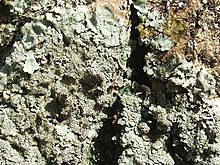Parmelia ernstiae
| Parmelia ernstiae | |
|---|---|

| |
| Scientific classification | |
| Kingdom: | Fungi |
| Division: | Ascomycota |
| Class: | Lecanoromycetes |
| Order: | Lecanorales |
| Family: | Parmeliaceae |
| Genus: | Parmelia |
| Species: | P. ernstiae
|
| Binomial name | |
| Parmelia ernstiae Feuerer & A.Thell (2002)
| |
Parmelia ernstiae is a species of foliose lichen in the family Parmeliaceae. It occurs in Europe.
Taxonomy[]
The lichen was described as a new species in 2002 by lichenologists Tassilo Feuerer and Arne Thell. The type specimen was collected from the trunk of European ash (Fraxinus excelsior) in Germany. It is a member of the Parmelia saxatilis species complex; it can be distinguished from that species by its strongly pruinose thallus and isidia.[1] Another member of this complex is .[2]
Distribution[]
First reported in Germany, Parmelia ernstiae has since been recorded Fennoscandia, including Denmark, southern Finland, and southwestern Sweden.[3] It was reported as new to Norway in 2019,[4] the same year it was reported from Belarus.[5] The eastern limits of its distribution extend to Bosnia-Herzegovina, the Czech Republic, and eastern Germany. Parmelia ernstiae typically grows on tree bark, although a single specimen from Denmark has been found growing on rock. Other than the substrate, it is morphologically and chemically identical to individuals that grow on bark.[2]
Description[]
The thallus of Parmelia ernstiae comprises small rounded lobes that rarely overlap each other. In the central parts of the thallus, the lobes are intermixed with isidia. The thallus has a pruinose coating, which helps to distinguish it from P. saxatilis. The lobes of the lookalike Parmelia serrana are larger than those of P. ernstiae, and typically overlap.[2]
Chemistry[]
Several secondary chemicals have been identified in Parmelia ernstiae, including: salazinic acid (a major compound), atranorin, , , , , , , and (all minor compounds). Parmelia ernstiae has the largest set of secondary chemicals in the Parmelia saxatilis group, and can be distinguished from those lookalikes by its secondary chemical composition.[2]
References[]
- ^ Feuerer, T.; Thell, A. (2002). "Parmelia ernstiae Feuerer & Thell – a new macrolichen from Germany". Mitteilungen aus dem Institut für Allgemeine Botanik Hamburg (in German). 30–32: 49–60.
- ^ a b c d Thell, Arne; Elix, John A.; Feuerer, Tassilo; Hansen, Eric Steen; Kärnefelt, Ingvar; Schüler, Nikolaus; Westberg, Martin (2008). "Notes on the systematics, chemistry and distribution of European Parmelia and Punctelia species (lichenized ascomycetes)" (PDF). Sauteria. 15: 545–559.
- ^ Thell, Arne; Tsurykau, Andrei; Persson, Per-Erik; Hansson, Mats (2017). "Parmelia ernstiae, P. serrana and P. submontana, three species increasing in the Nordic countries". Graphis Scripta. 29: 24–32.
- ^ Haugan, Reidar; Timdal, Einar (2019). "The morphologically cryptic lichen species Parmelia ernstiae and P. serrana new to Norway". Graphis Scripta. 31: 5–13.

- ^ Tsurykau, Andrei; Bely, Pavel; Golubkov, Vladimir; Persson, Per-Erik; Thell, Arne (2019). "The lichen genus Parmelia (Parmeliaceae, Ascomycota) in Belarus". Herzogia. 32 (2): 375–384. doi:10.13158/heia.32.2.2019.375. S2CID 209522900.
- Parmelia
- Lichens described in 2002
- Lichens of Europe